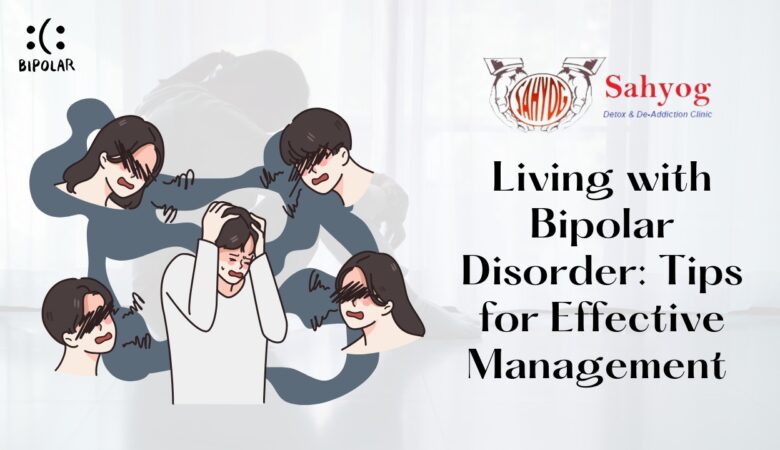Living with Bipolar Disorder: Tips for Effective Management
Introduction Living with Bipolar Disorder can be an overwhelming and challenging experience. The constant mood swings, from high to low and back again, can make it difficult to maintain relationships, hold down a job or simply enjoy a moment of peace. But there is hope. With the right treatment and management techniques, living with bipolar disorder can become more manageable. In this post, we’ll explore tips for effective management of bipolar disorder so that you can take control of your life once again! What is Bipolar Disorder? Bipolar disorder is a mental health condition that affects millions of people around the world. It’s characterized by extreme mood swings, ranging from periods of intense highs (mania or hypomania) to episodes of deep depression. During manic episodes, individuals may feel euphoric, have excessive energy levels and engage in risky behaviors such as overspending money or substance abuse. On the other hand, during depressive episodes, they may feel hopeless and lethargic with a lack of interest in activities they once enjoyed. There are different types of bipolar disorder depending on the severity and duration of symptoms experienced during each episode. Bipolar I involves severe mania lasting at least 7 days while Bipolar II features hypomania which lasts for only four days. The exact causes of bipolar disorder are unclear but there seems to be a genetic component involved as well as environmental factors that can contribute to its development. If you suspect that you or someone you know has bipolar disorder, it is important to seek help from qualified professionals who can provide an accurate diagnosis and appropriate treatment plan tailored for your specific needs. Types of Bipolar Disorder Bipolar disorder is a mental illness that affects millions of people worldwide. It is characterized by extreme shifts in mood, energy levels, and behavior. There are different types of disorder, each with its own unique symptoms and treatment options. The most common type of disorder is Bipolar Disorder. This type involves episodes of mania or hypomania (less severe form), as well as periods of depression. During manic episodes, individuals may feel euphoric or irritable and engage in risky behaviors. Another type is Bipolar II Disorder which involves cycles between depressive episodes and hypomanic episodes but not full-blown mania like in Bipolar I Disorder. Cyclothymic Disorder is another type where the individual experiences numerous periods of hypomania and mild depression over the course of two years without meeting the criteria for a major depressive episode. Lastly there’s Rapid-Cycling Bipolar Disorder which can occur within any subtype to describe four or more mood swings occurring within one year that meet criteria for an episode; these frequent changes make it difficult to manage day-to-day living. It’s important to note that each person’s experience varies greatly – some may only have severe manic episodes while others only experience depressive ones. Regardless, seeking professional help from a licensed mental health provider remains critical to receiving an accurate diagnosis and appropriate treatment plan tailored specifically for you. Symptoms of Bipolar Disorder Bipolar disorder can be a challenging condition to live with, and recognizing the symptoms is crucial for effective management. The most common symptoms are extreme mood swings that range from high-energy phases or manic episodes to low periods of depression. During manic episodes, individuals may experience increased energy levels, racing thoughts, impulsivity, and poor decision-making skills. They may also have difficulty sleeping and display erratic behavior. During depressive episodes, individuals often feel sad or empty and lose interest in activities they once enjoyed. They may also experience changes in appetite or sleep patterns. Other symptoms of bipolar disorder can include irritability, anxiety, restlessness, feelings of worthlessness or guilt during depressive episodes. In some cases, individuals with disorder may exhibit psychotic symptoms such as hallucinations or delusions during either phase. It’s important to remember that each person with bipolar disorder will have unique experiences regarding their mood swings and other related symptomatology. Therefore it’s essential to work closely with mental health professionals to manage these symptoms effectively over time while learning how best to maintain healthy habits that promote stability over time. Causes of Bipolar Disorder Bipolar disorder is a complex condition that affects millions of people worldwide. Although the exact causes of bipolar disorder are still not fully understood, experts believe that it is caused by a combination of genetic and environmental factors. Research has shown that there may be a genetic predisposition to bipolar disorder, meaning that some individuals may inherit certain genes that make them more susceptible to developing the condition. However, having these genes does not necessarily mean that someone will develop bipolar disorder. Environmental factors such as stress, trauma, substance abuse and major life changes can trigger or exacerbate symptoms of bipolar disorder in those who are already genetically vulnerable. Hormonal imbalances and disruptions in circadian rhythms have also been linked to the development of bipolar disorder. It’s important to note that while we understand some potential causes for this mental illness, every individual’s experience with bipolar is unique and multifaceted. As research continues on this topic, it’s likely we’ll learn even more about what exactly contributes to its onset over time. Treatment for Bipolar Disorder Effective treatment for bipolar disorder involves a combination of medication and therapy. The goal of treatment is to stabilize mood swings, reduce symptoms, and improve overall quality of life. Medication options include mood stabilizers such as lithium, antipsychotics, antidepressants, and anti-anxiety medications. It is important to work closely with a psychiatrist or other mental health professional to find the right medication(s) that works best for you. Therapy can also be an essential part of bipolar disorder management. Cognitive-behavioral therapy (CBT), interpersonal therapy (IPT), and family-focused therapy are all effective forms of treatment in helping individuals understand their illness, develop coping skills, manage stressors and improve relationships. In addition to traditional medical treatments and therapies, lifestyle changes can also play a role in managing bipolar disorder symptoms. Regular exercise, healthy eating habits, consistent sleep patterns and minimizing stressors can










